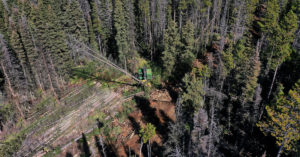More than just dead wood
Posted: October 18, 2021Beetle-killed Trees can be More than Just Dead Wood
By Clare Tattersall

This situation is not unique to the country’s westernmost province, or Canada. Similar devastation can be found throughout the Western United States. However, all is not lost, thanks to people like Ryan Palma, whose passion for healthy forests led him to start Sustainable Lumber Co. Based in Missoula, Mont., the company specializes in producing products from recycled, reclaimed, and sustainable timber. This includes beetle-killed pine. Instead of letting these trees rot on the stump, Sustainable Lumber salvages them. Here, Palma provides insight into beetle-killed pine and the manufacture of this type of flooring.
What is beetle-killed pine?
Beetle-killed pine is the term used for pine trees killed by the mountain pine beetle, a member of a group of insects known as bark beetles. This small beetle has been destroying trees at a rate of more than 100 million acres of timber in Canada and the U.S., with an 80 to 90 percent kill rate. The mountain pine beetle bores into the wood, lays eggs, and ultimately suffocates the tree by cutting off its water and nutrient supply. The beetle lives out its life cycle within the bark, except for when adults emerge and attack new trees.
What happens to these trees?
After the beetle kills a tree it becomes known as dead standing timber. If left in the forest, the dead tree will eventually fall over, decay and either become fuel for catastrophic wildfires or release its carbon back into the atmosphere, resulting in higher greenhouse gases. However, if harvested within five years, the tree can be used for wood products.
What are the most common uses of beetle-killed pine?
Since these trees are often riddled with splits, checks, cracks, and rot pockets, and they have a distinct blue ‘stain’ (from the fungus carried by the mountain pine beetle that stops the tree from producing its natural defense resin), beetle-killed pine is commonly used to make siding, wall planks and paneling, cabinets, doors, furniture, moulding and flooring. Its unique character and tint — coloring can include blue, purple, brown, orange, yellow, red, and pink — is often prized by artisans and craftsmen. And because it is an all-natural and organic product, no stains or paints are needed to enhance the wood.
Is the wood safe to use?
Yes, the blue staining is purely cosmetic and has no effect on the structural integrity of the wood.
What’s involved in the manufacture of beetle-killed pine flooring?
At Sustainable Lumber, we hand pick beetle-killed ponderosa pine trees that range between 100 and 400 years old. Because of its thick bark, ponderosa pines hold moisture in the tree 10 times longer than commercially harvested lodgepole pine. This moisture allows the fungus from the mountain pine beetle to flourish and create the wide array of colours you see in our flooring.
After visually grading and methodically cutting the trees to maximize the natural colour and character, we slowly kiln dry every plank to six to eight percent moisture. This improves stability and helps reduce any chance of future movement on the board. It also kills 100 percent of the fungus that created the natural discolouration in the tree.
Next, every board is inspected and milled into tongue and groove flooring. After milling, we check the boards again and cut out any defects by hand. Each individual flooring board is then end-matched (tongue and groove on the ends). Our finished product is held to a higher standard and graded to our 99 percent usable tolerances.

